Is Bluebell Safe to Eat
Bluebells are not safe to eat. Despite their beauty, these flowers contain toxic compounds called glycosides, which can harm your heart, nervous system, and digestive tract. If ingested, you might experience symptoms like gastrointestinal upset, lethargy, and respiratory distress. The bulbs are particularly dangerous, containing the highest concentration of harmful substances. While some cultures historically used bluebells for medicinal purposes, modern science doesn't support these practices due to safety concerns. It's essential to remember that many bluebell species are protected, making foraging illegal in certain regions. If you're curious about edible flowers, there are safer alternatives to explore that won't put your health at risk.
This post may contain affiliate links. If you make a purchase through these links, I may earn a commission at no additional cost to you. Additionally, portions of this post may be generated using artificial intelligence (AI) technology. While we strive for accuracy, please be aware that AI-generated content may not always be perfect and should be fact-checked when necessary.
The Spatula Scoops
- Bluebells contain toxic glycosides affecting the heart, nervous system, and digestive tract, making them unsafe for consumption.
- Ingesting bluebells can cause gastrointestinal upset, lethargy, and respiratory distress, with bulbs having the highest toxin concentration.
- Some bluebell species are edible, while others are toxic; expert consultation is crucial before considering consumption.
- Many bluebell species are protected, making foraging illegal in certain regions.
- Alternative edible flowers like nasturtiums and pansies are safer options for culinary use.
Identifying Bluebell Species
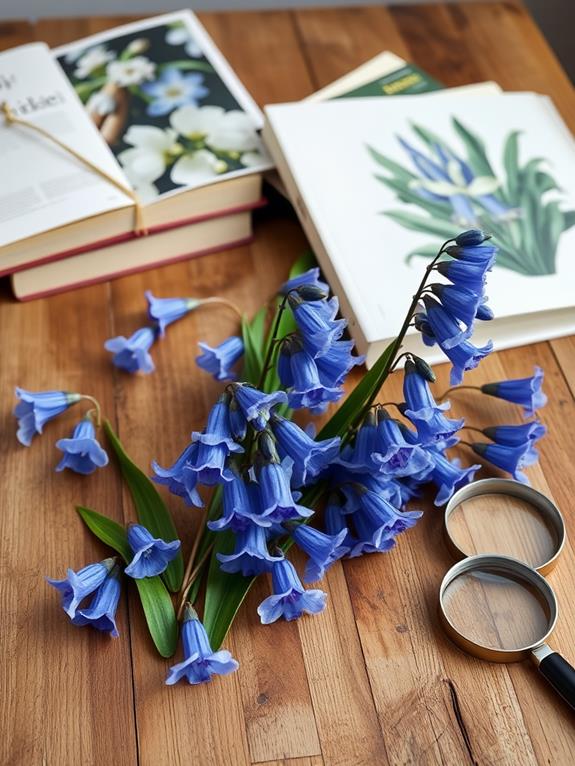
The vibrant blue carpet of bluebells in a springtime forest is a sight to behold. However, before you consider eating these beautiful flowers, it's vital to identify the correct species. There are several types of bluebells, and not all are safe for consumption. The most common species you'll encounter are the English bluebell (Hyacinthoides non-scripta) and the Spanish bluebell (Hyacinthoides hispanica). It's important to be cautious, much like when selecting the right salt for your cooking, as not all choices offer the same benefits or safety; for example, some salts, like Diamond Crystal Kosher Salt Flakes, provide a purer flavor without additives.
To identify English bluebells, look for their distinctive drooping, bell-shaped flowers that appear on one side of the stem. They're typically a deep blue-purple color with curled-back petals. Spanish bluebells, on the other hand, have more upright stems with flowers all around them. Their petals don't curl back as much, and they can be various shades of blue, pink, or white.
It's significant to note that while some bluebell species are edible, others can be toxic. Always consult an expert or reliable field guide before consuming any wild plants. Additionally, many bluebell species are protected in certain regions, so foraging may be illegal. When in doubt, it's best to admire these beautiful flowers in their natural habitat without disturbing them.
Nutritional Profile of Bluebells
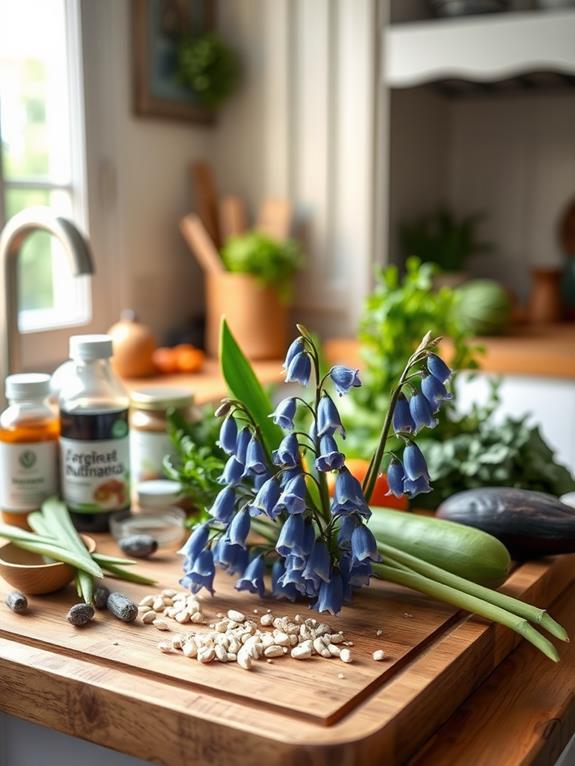
Delving into the nutritional profile of bluebells reveals a complex composition that's often overlooked. While you might not typically consider bluebells as a food source, understanding their nutritional content can provide insights into their potential uses and effects on the ecosystem.
Let's examine some key components found in bluebells:
| Nutrient | Amount per 100g | Function in plants |
|---|---|---|
| Carbohydrates | 15-20g | Energy storage |
| Proteins | 2-3g | Structural support |
| Fiber | 3-5g | Cell wall component |
| Vitamin C | 10-15mg | Antioxidant |
| Calcium | 30-40mg | Cellular signaling |
You'll notice that bluebells contain a variety of nutrients, though in relatively small amounts compared to common food plants. They're rich in carbohydrates, which serve as the plant's primary energy source. The protein content, while low, contributes to the plant's structure. Fiber, an essential component of plant cell walls, aids in the bluebell's rigidity. Vitamin C acts as an antioxidant, protecting the plant from oxidative stress. Calcium plays a significant role in cellular signaling within the plant.
Potential Health Risks
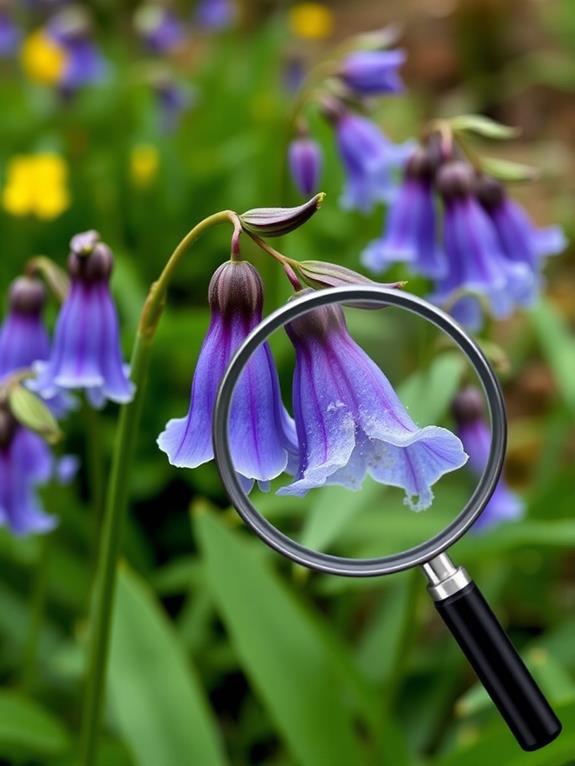
When considering eating bluebells, you should be aware of potential health risks. There's a chance of foodborne illness if the plants aren't properly cleaned or if they've been exposed to contaminants in the soil or environment. Additionally, undercooked chicken poses risks for foodborne illnesses, so it's essential to apply similar caution with bluebells. Some people may experience allergic reactions to bluebells, which could range from mild skin irritation to more severe symptoms, so it's important to exercise caution if you're trying them for the first time.
Foodborne Illness Concerns
Over the years, concerns about foodborne illnesses have cast a shadow over Bluebell's reputation. You might be wondering about the specific risks associated with consuming this beloved ice cream brand. The primary concern stems from potential bacterial contamination, particularly Listeria monocytogenes, which can cause serious health issues.
In 2015, Bluebell faced a major crisis when their products were linked to a Listeria outbreak. This incident resulted in multiple hospitalizations and deaths, leading to a complete recall of their products. Since then, the company has implemented stricter food safety measures, but the memory of this event still lingers in consumers' minds.
It's important to understand that while rare, foodborne illnesses can occur with any food product. Bluebell, like other ice cream manufacturers, must adhere to rigorous food safety standards set by the FDA. These include regular testing, proper storage temperatures, and stringent hygiene practices throughout the production process.
As a consumer, you can minimize risks by checking for any recall notices, ensuring proper storage, and consuming the product before its expiration date.
Allergic Reaction Possibilities
Beyond foodborne illness concerns, it's important to contemplate potential allergic reactions when consuming Bluebell ice cream. You might be allergic to some of the ingredients commonly found in their products. Milk, eggs, and nuts are common allergens that can cause reactions ranging from mild discomfort to severe anaphylaxis.
Here's a breakdown of potential allergens and their symptoms:
| Allergen | Common Symptoms | Severity |
|---|---|---|
| Milk | Hives, nausea | Mild-Moderate |
| Eggs | Stomach pain | Mild-Severe |
| Nuts | Anaphylaxis | Severe |
| Soy | Itching, swelling | Mild |
If you have known allergies, carefully read Bluebell's ingredient lists. They're required by law to list major allergens on their packaging. You'll find this information clearly labeled, making it easier for you to make informed decisions. If you're unsure about your allergies, consider consulting an allergist for testing. They can provide a thorough assessment of your potential reactions to common ice cream ingredients. Remember, it's always better to err on the side of caution when it comes to food allergies.
Traditional Uses of Bluebells
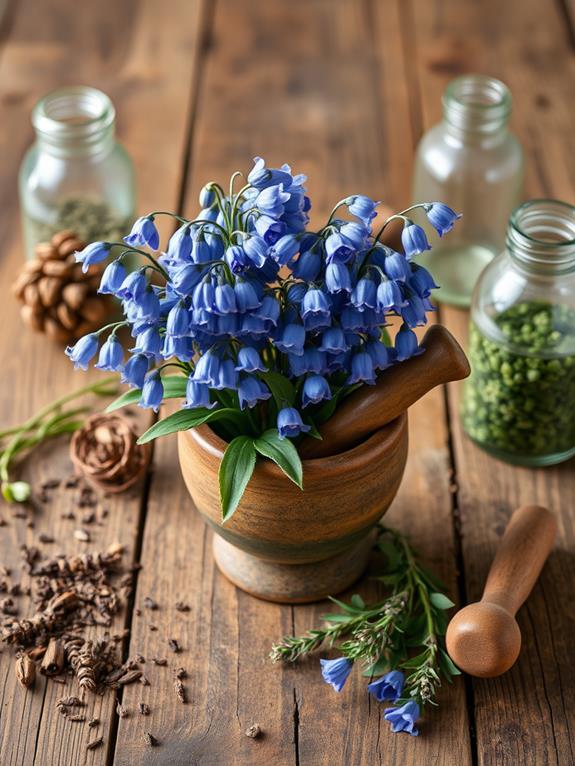
You might be surprised to learn that bluebells have a long history of traditional uses, both medicinal and culinary. In folk medicine, bluebell bulbs were sometimes used to treat various ailments, including leprosy and spider bites, though these applications aren't scientifically proven. Curiously, the diverse ecosystems of places like Costa Rica support a range of unique plant species, some of which may have similar traditional uses in indigenous cultures biodiversity of plants. Historically, some cultures incorporated bluebells into their cuisine, using the bulbs as a source of starch, but this practice isn't common today due to concerns about toxicity and conservation efforts.
Medicinal Applications
Throughout history, bluebells have played a role in traditional medicine, despite their potential toxicity. You'll find that herbalists and folk healers have utilized various parts of the plant for different purposes. The bulbs, for instance, have been used to create a diuretic, which helps increase urine production and flush out toxins from the body. Some practitioners have applied bluebell extracts topically to treat skin conditions like eczema or minor wounds.
In folk remedies, you might encounter bluebell preparations for treating leukemia, though it's important to emphasize that there's no scientific evidence supporting this use. The plant's alleged styptic properties have led to its application in stopping nosebleeds and other minor bleeding. Some traditional healers have also used bluebell concoctions to address joint pain and inflammation associated with conditions like arthritis.
However, it's vital to approach these medicinal applications with caution. Bluebells contain glycosides, which can be toxic if ingested in large quantities. Modern medicine doesn't typically employ bluebells due to safety concerns and lack of clinical evidence. Always consult a healthcare professional before using any herbal remedies, especially those derived from potentially toxic plants like bluebells.
Culinary History
Despite their potential toxicity, bluebells have a surprising history in traditional cuisine. You might be wondering how these potentially harmful plants found their way onto people's plates. Historically, some European cultures incorporated bluebell bulbs into their diets during times of scarcity. They'd boil the bulbs to reduce their toxicity and extract a starchy substance, similar to how you'd prepare other root vegetables.
In certain regions, people used bluebell sap as a natural adhesive for bookbinding, demonstrating the plant's versatility beyond food. While not a staple, bluebells occasionally appeared in folk remedies and seasonal dishes. It is essential to recognize that these practices were born out of necessity rather than culinary preference.
Today, you won't find bluebells on restaurant menus or in cookbooks. Modern understanding of their toxic properties has led to their exclusion from contemporary cuisine. Instead, they're primarily appreciated for their aesthetic value in gardens and woodlands. If you're curious about edible flowers, it's best to stick to well-known, safe options like nasturtiums or pansies, which have a more established culinary tradition and are free from the risks associated with bluebells.
Toxicity in Animals

For animals, bluebells can pose serious health risks. If you're a pet owner or livestock keeper, you'll want to be aware of the potential dangers these plants present. Bluebells contain glycosides, which are toxic compounds that can affect an animal's heart, nervous system, and digestive tract. When ingested, these toxins can cause symptoms ranging from mild gastrointestinal upset to more severe conditions like cardiac arrhythmias. Additionally, it's essential to guarantee safe environments for pets, including keeping potentially harmful items like natural baking products out of reach.
Dogs and cats are particularly susceptible to bluebell poisoning. If you notice your pet chewing on bluebell leaves or bulbs, it's essential to act quickly. Symptoms you might observe include vomiting, diarrhea, lethargy, and in severe cases, difficulty breathing or collapse. Horses and cattle are also at risk, especially if they graze in areas where bluebells grow abundantly. For these larger animals, the consequences can be even more dire, potentially leading to colic or liver damage.
It's important to note that while all parts of the bluebell plant are toxic, the bulbs contain the highest concentration of harmful compounds. If you suspect your animal has ingested any part of a bluebell, don't hesitate to contact your veterinarian immediately for guidance and treatment.
Culinary Applications and Alternatives
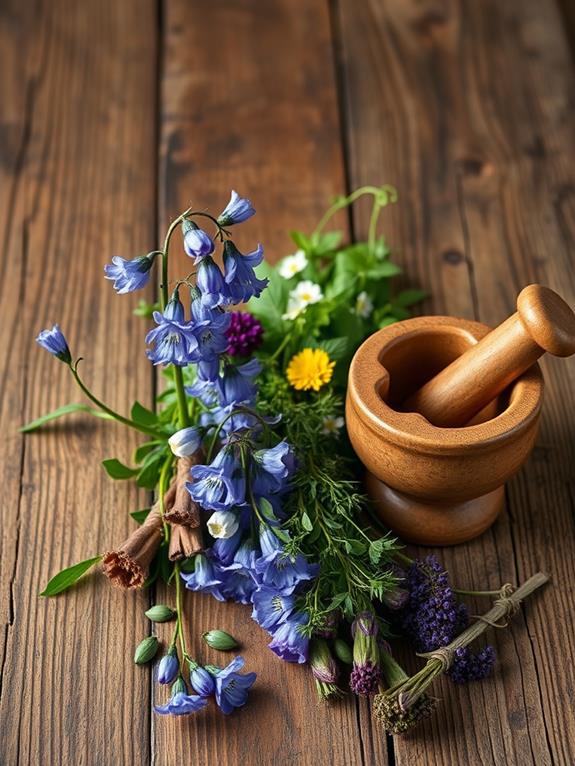
While bluebells pose risks to animals, you might wonder about their potential culinary uses for humans. It's essential to mention that bluebells aren't commonly used in cooking due to their toxicity. You shouldn't attempt to eat or prepare bluebells for consumption, as they contain glycosides that can cause digestive issues and other health problems. As a reminder, whole bay leaves are indigestible and can lead to gastrointestinal discomfort if swallowed, highlighting the importance of knowing what edible plants are safe for consumption.
Instead, consider safe alternatives that offer similar visual appeal. Edible flowers like violets, pansies, or borage can add a delicate, floral touch to your dishes without the risks associated with bluebells. These flowers are often used in salads, as cake decorations, or candied for desserts. If you're looking for blue-colored ingredients, try using butterfly pea flowers or blue spirulina powder. These natural food colorings can create vibrant blue hues in various recipes.
When incorporating edible flowers into your culinary creations, always verify they're from a trusted source and free from pesticides. Research each flower's flavor profile and potential uses to maximize their impact in your dishes. Remember, while some flowers are edible and even nutritious, others can be harmful, so always prioritize safety in your culinary experiments.
Legal Considerations for Foraging

Considering the potential dangers of consuming bluebells, it's vital to understand the legal implications of foraging for wild plants. In many areas, it's illegal to uproot or pick bluebells without permission from the landowner. You'll need to be aware of local laws and regulations before attempting to forage for any wild plants, including bluebells. Additionally, it's worth noting that some regions have specific protected plants, akin to how Chile has unique species in its diverse landscapes, such as endemic flora that should remain undisturbed in their natural habitat, reflecting the significance of conservation efforts (rich biodiversity).
When foraging, always follow these guidelines:
- Obtain permission from the landowner before collecting plants on private property.
- Research and adhere to local conservation laws and protected species regulations.
- Never collect plants from nature reserves or protected areas without proper authorization.
It's important to remember that some plants, like bluebells, may be protected species in certain regions. Foraging for these plants could result in fines or legal penalties. Additionally, you should be aware of the concept of "leave no trace" when foraging. This principle emphasizes minimizing your impact on the environment and preserving ecosystems for future generations. By following these guidelines and staying informed about local regulations, you can enjoy foraging responsibly while avoiding legal troubles and protecting the natural environment.
Conservation and Ethical Harvesting
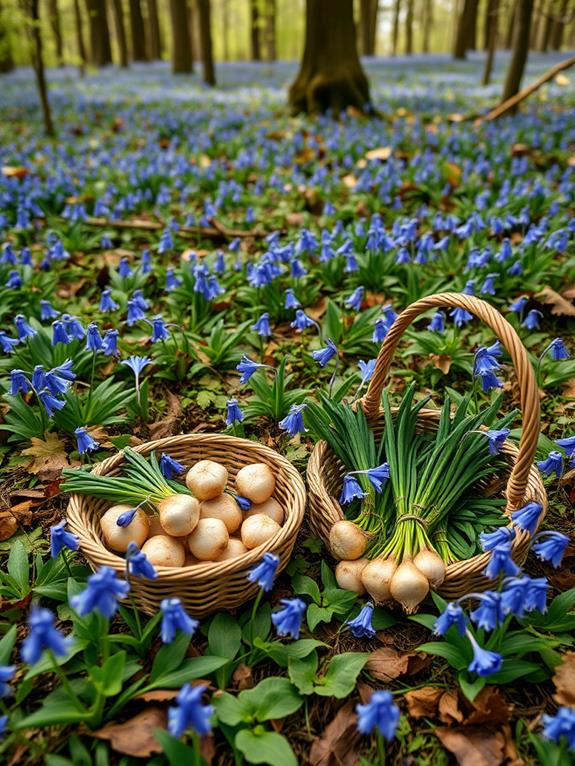
Conservation efforts for bluebells often go hand-in-hand with ethical harvesting practices. When you're foraging for bluebells, it's essential to reflect on the plant's ecological importance and its role in maintaining biodiversity, much like how bears play significant roles in their ecosystems with unique adaptations and behaviors. You'll want to follow the "leave no trace" principle, which means taking only what you need and leaving plenty for wildlife and other foragers, as well as maintaining a balance similar to bears' diverse feeding habits.
To practice ethical harvesting, you should never uproot entire plants. Instead, carefully snip individual flowers or leaves, allowing the plant to regenerate. It's also important to disperse your harvesting over a wide area to prevent localized damage. Remember, bluebells are slow to establish and can take years to recover from overharvesting.
Many regions have specific regulations to protect bluebells. In the UK, for example, it's illegal to dig up bluebells in the wild. You should always check local laws before foraging. Additionally, think about alternatives like growing your own bluebells or purchasing them from sustainable sources. By adopting these practices, you'll contribute to the conservation of these beautiful flowers while still enjoying their benefits responsibly.
Frequently Asked Questions
Can Bluebells Be Grown in Home Gardens for Culinary Purposes?
You shouldn't grow bluebells in your home garden for culinary purposes. While they're beautiful flowers, bluebells aren't edible and can be toxic if ingested. All parts of the plant contain glycosides, which can cause digestive issues and more serious health problems. Instead, focus on growing edible flowers like nasturtiums, pansies, or marigolds if you want to add floral elements to your cooking. These are safe, beautiful, and can enhance both the visual appeal and flavor of your dishes.
Are There Any Bluebell-Inspired Products Available in the Market?
You'll find various bluebell-inspired products in the market, though they're not as common as other floral-themed items. You can discover bluebell-scented perfumes, soaps, and candles that capture the flower's delicate fragrance. Some artisans create bluebell-themed jewelry, pottery, and home decor items. In the culinary world, you might encounter bluebell-flavored chocolates or teas, though these are often artificially flavored. Remember, many of these products are inspired by bluebells rather than containing actual bluebell components.
How Do Bluebells Compare to Other Edible Flowers in Taste?
You'll find that bluebells don't compare favorably to other edible flowers in taste. Unlike popular edible blooms like nasturtiums, pansies, or lavender, bluebells aren't typically consumed. They're not known for their flavor and aren't used in culinary applications. In fact, bluebells contain glycosides, which can be toxic if ingested in large quantities. It's best to enjoy bluebells for their visual beauty rather than their taste. Stick to well-known edible flowers for culinary purposes to guarantee safety and flavor.
Can Bluebell Extract Be Used in Natural Medicine or Supplements?
Did you know that over 60% of plant-based medicines come from traditional uses? When it comes to bluebell extract, you'll find it's not commonly used in natural medicine or supplements. While some folk remedies mention bluebells, there's little scientific evidence supporting their medicinal use. It's essential to remember that bluebells contain glycosides, which can be toxic. Always consult a healthcare professional before using any plant-based remedies, as safety and efficacy aren't guaranteed without proper research and testing.
Are There Any Cultural or Religious Significance Associated With Eating Bluebells?
You'll find that bluebells don't hold significant cultural or religious importance in most traditions. While some folklore connects them to fairies or woodland spirits, they're not widely associated with specific beliefs or practices. In some European cultures, they're seen as symbols of humility or gratitude. However, it is crucial to highlight that picking or eating bluebells is often discouraged or illegal in many areas due to conservation efforts, rather than cultural or religious reasons.





